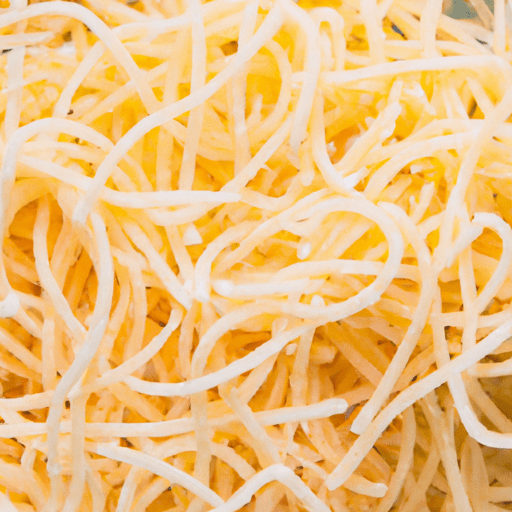The Versatility and Delight of Cooked Angel Hair Pasta
If you’re a pasta lover, you’re probably familiar with a vast range of pasta shapes, each with its distinct characteristics and culinary uses. One such pasta, the delicate and slender angel hair pasta, holds a special place in the hearts of many pasta enthusiasts. In this blog post, we will take a closer look at cooked angel hair pasta, exploring its taste, common uses in cooking, nutritional value, and a few interesting historical tidbits.
The Taste and Texture of Angel Hair Pasta
Angel hair pasta, also known as capellini or “fine hair,” is an exquisite pasta variety characterized by its long, thin strands. When cooked to perfection, it has a tender, almost silky texture that effortlessly glides across your palate. With a delicate flavor profile, angel hair pasta allows the sauce to shine, enhancing its overall taste.
Common Culinary Uses
Due to its delicate nature, angel hair pasta pairs wonderfully with light and delicate sauces. While traditional tomato-based sauces like marinara and arrabbiata work well, it truly shines when paired with olive oil, garlic, and fresh herbs. The simplicity of this combination brings out the pasta’s lightness and delicate flavors.
Angel hair pasta is also a popular choice for pasta salads, as its slim strands beautifully absorb dressings and vinaigrettes, creating a refreshing dish for warm summer days. Another classic preparation is tossing cooked angel hair pasta with a medley of sautéed vegetables or seafood, providing a satisfying and wholesome meal.
Nutritional Value
From a nutritional standpoint, angel hair pasta offers many benefits. Made from durum wheat semolina, it provides a good source of complex carbohydrates, which are vital for energy. Angel hair pasta is low in fat and cholesterol-free, making it a healthier choice compared to some other pasta varieties.
One important aspect to consider is portion control, as it’s easy to go overboard with pasta. Be mindful of your portion sizes and aim to incorporate a balanced mix of vegetables, proteins, and healthy fats for a complete and nutritious meal.
Historical Significance
Although angel hair pasta is commonly associated with Italian cuisine, its exact origin is difficult to pinpoint. Pasta, in general, has a long history dating back centuries. It is believed that Arab traders introduced pasta to Italy during the Middle Ages, and it soon became a staple in Italian cooking.
Angel hair pasta gained popularity in the United States during the 1980s, where it was embraced for its delicate texture and quick cooking time. Today, it is loved by many for its versatility and ability to complement a wide variety of flavors.
Cooked angel hair pasta is a beloved pasta variety that offers a delightful eating experience. Its delicate strands, combined with its tender texture and mild taste, make it a perfect canvas for a multitude of sauces and toppings. Whether you’re enjoying a classic olive oil and garlic dish or a refreshing pasta salad, angel hair pasta is sure to satisfy your cravings.
Remember to savor the simplicity of this pasta and experiment with different ingredients to create your own culinary masterpiece. So next time you’re in the mood for pasta, why not give angel hair pasta a try? You won’t be disappointed!
Angel Hair Pasta
Origin: Angel hair pasta, also known as capellini or “fine hair,” is a very thin pasta originating from Italy. It is believed to have been created in the Naples region.
Common Uses: Angel hair pasta is typically used in delicate dishes, as its thin and delicate texture pairs well with light sauces. It is often served with seafood, such as shrimp or scallops, or with simple butter and herb sauces.
Nutritional Benefits: Angel hair pasta is made from durum wheat semolina, which contains carbohydrates, protein, and dietary fiber. It is low in fat and cholesterol-free. Additionally, it provides essential B vitamins, iron, and some minerals.
Unique Properties: The thinness of angel hair pasta allows it to cook quickly, usually in just a few minutes. It is delicate and can sometimes become mushy if overcooked. Its delicate texture is often preferred by those who enjoy lighter pasta dishes. Because it’s so thin, it cooks faster than thicker pasta varieties and requires less time in boiling water.
Historical Significance: Angel hair pasta is a relatively recent addition to pasta families. It was introduced in the 1960s, and its popularity grew due to its delicate texture, quick cooking time, and ability to absorb flavors easily.
It’s important to note that while angel hair pasta can be a part of a balanced diet, it should be consumed in moderation as part of an overall healthy eating plan, considering individual dietary needs and preferences.




Use the share button below if you liked it.
It makes me smile, when I see it.